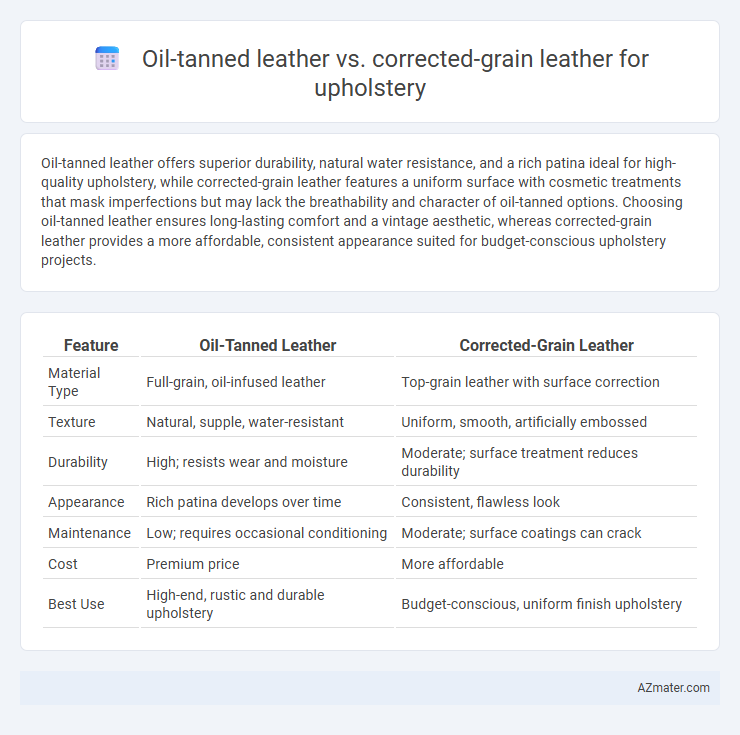Oil-tanned leather offers superior durability, natural water resistance, and a rich patina ideal for high-quality upholstery, while corrected-grain leather features a uniform surface with cosmetic treatments that mask imperfections but may lack the breathability and character of oil-tanned options. Choosing oil-tanned leather ensures long-lasting comfort and a vintage aesthetic, whereas corrected-grain leather provides a more affordable, consistent appearance suited for budget-conscious upholstery projects.
Table of Comparison
| Feature | Oil-Tanned Leather | Corrected-Grain Leather |
|---|---|---|
| Material Type | Full-grain, oil-infused leather | Top-grain leather with surface correction |
| Texture | Natural, supple, water-resistant | Uniform, smooth, artificially embossed |
| Durability | High; resists wear and moisture | Moderate; surface treatment reduces durability |
| Appearance | Rich patina develops over time | Consistent, flawless look |
| Maintenance | Low; requires occasional conditioning | Moderate; surface coatings can crack |
| Cost | Premium price | More affordable |
| Best Use | High-end, rustic and durable upholstery | Budget-conscious, uniform finish upholstery |
Introduction to Upholstery Leather Types
Oil-tanned leather offers a rich, natural finish with enhanced durability and water resistance, making it ideal for high-use upholstery that requires longevity and a rustic look. Corrected-grain leather undergoes surface abrasion and embossing, resulting in a uniform appearance that easily hides imperfections, suited for contemporary furniture requiring consistent texture and color. Both types serve distinct upholstery needs, with oil-tanned leather prized for its character and corrected-grain for its flawless aesthetic.
What is Oil-Tanned Leather?
Oil-tanned leather is a type of leather treated with oils and waxes during the tanning process, resulting in enhanced durability, water resistance, and a rich, natural finish ideal for upholstery. This leather maintains its natural grain, offering a soft texture and developing a unique patina over time, which makes it highly desirable for furniture that ages gracefully. Compared to corrected-grain leather, oil-tanned leather provides superior breathability and a more authentic appearance due to minimal surface alterations.
What is Corrected-Grain Leather?
Corrected-grain leather is a type of leather that has been sanded and buffed to remove imperfections, then coated with an artificial layer to create a uniform appearance. This finishing process often involves embossing a grain pattern to mimic natural leather textures, enhancing durability and stain resistance for upholstery applications. Compared to oil-tanned leather, corrected-grain leather offers a more affordable, consistent look but may lack the rich patina and breathability of untreated, natural leather surfaces.
Key Differences in Manufacturing Process
Oil-tanned leather undergoes a tanning process using oils and waxes that penetrate the hide, resulting in a supple, water-resistant surface with natural markings preserved. Corrected-grain leather is made by sanding and buffing the hide's surface to remove imperfections, followed by an artificial grain texture applied with pigments and coatings for uniform appearance. The manufacturing difference lies in oil-tanning enhancing natural durability via oils, whereas corrected-grain involves mechanical correction and surface finishes to achieve a consistent look.
Durability and Longevity Comparison
Oil-tanned leather offers superior durability and water resistance due to its natural treatment process, making it highly resistant to cracks and wear over time. Corrected-grain leather undergoes sanding and coating to hide imperfections, which can reduce its breathability and overall lifespan compared to oil-tanned leather. For upholstery, oil-tanned leather typically provides longer-lasting strength and a more robust resistance to everyday use and environmental factors.
Comfort and Feel: Texture Analysis
Oil-tanned leather offers a rich, supple texture with natural grain patterns that enhance comfort by adapting to body heat and moisture, providing a soft, breathable feel ideal for upholstery. Corrected-grain leather undergoes heavy sanding and coating to mask imperfections, resulting in a uniform but less breathable surface that may feel stiffer and less natural compared to oil-tanned leather. The tactile experience of oil-tanned leather is generally warmer and more pliable, whereas corrected-grain leather prioritizes durability over the luxurious, organic texture favored in high-end furniture.
Maintenance and Care Requirements
Oil-tanned leather requires regular conditioning with specialized oils to maintain its flexibility and rich patina, effectively preventing cracks and water damage. Corrected-grain leather demands consistent cleaning with mild soap solutions and occasional application of protective conditioners to preserve its uniform surface and resist stains. Both types benefit from avoiding direct sunlight and heat exposure to extend their upholstery lifespan.
Aesthetic Appeal and Color Options
Oil-tanned leather showcases a rich, natural patina that enhances aesthetic appeal with deep, earthy tones and a supple texture, ideal for a luxurious and authentic look in upholstery. Corrected-grain leather offers a uniform surface that allows for a wider range of color options and finishes, catering to more contemporary or customized design preferences. While oil-tanned leather emphasizes natural beauty and durability, corrected-grain leather excels in versatility and consistency of color for varied interior styles.
Cost Considerations for Upholstery Projects
Oil-tanned leather typically commands a higher price due to its durable, natural finish and superior aging properties, making it a long-term investment for upholstery projects. Corrected-grain leather, with its sanded surface and embossed grain, offers a more budget-friendly option but may require more frequent replacement or repair over time. Assessing project budgets against desired longevity and appearance helps determine the cost-effectiveness of choosing oil-tanned versus corrected-grain leather for upholstery.
Which Leather is Best for Upholstery?
Oil-tanned leather offers superior durability, water resistance, and a rich, natural patina, making it ideal for high-use upholstery that requires longevity and a rugged aesthetic. Corrected-grain leather undergoes surface alterations to remove imperfections, providing a uniform appearance but often sacrificing breathability and developing a synthetic feel over time. For upholstery, oil-tanned leather is best suited due to its resilience, natural texture retention, and ability to age gracefully under frequent use.

Infographic: Oil-tanned leather vs Corrected-grain leather for Upholstery
 azmater.com
azmater.com